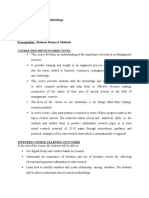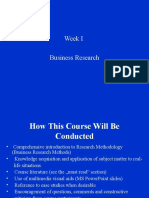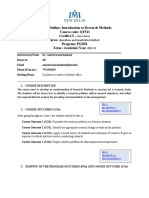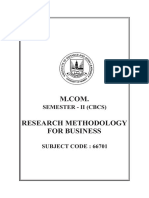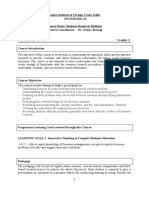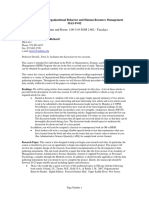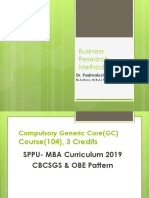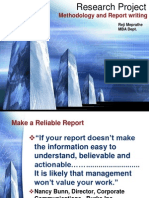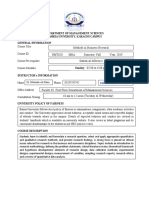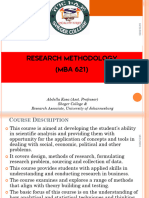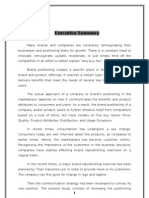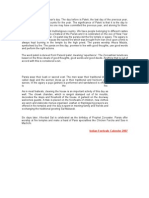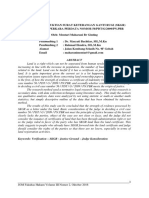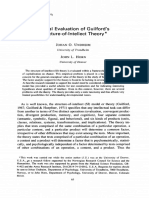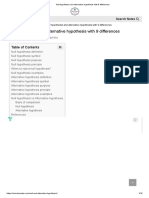Business Statistics and Research Methods1
Course overview
As a professional HR manager, you have a number of obligations to your organization and
society. First, you are expected to be up to date with the latest experiences of other HR
professionals and academics across the world in your area of expertise. Second, when faced
with an organizational issue, you are expected to go beyond mere intuition or judgment and
provide solutions based on sound theory and accepted practice. Finally, you are expected to
communicate and share your own insights and experiences with other HR professionals. In
order to be able to fulfill these obligations as an HR professional, you must be able to:
1. Search, read, understand, and apply the insights of academics and practitioners across
the world in your area of interest;
2. Structure a managerial problem such that it is solved by systematically collecting
evidence and analyze data in a systematic manner to arrive at practical insights for
improvement.
3. Express your thoughts and experiences in writing such that they educate and persuade
other academics and practitioners; and
Research is a careful and systematic inquiry into a particular subject2. Quantitative research
addresses research objectives through empirical assessments that involve numerical
measurement and analysis.3
Over the last seventy years or so, management research has evolved a comprehensive toolkit
of approaches to inquire into the strategic, tactical, and operational problems being faced by
managers. Being familiar with these approaches and knowing their strengths and limitations
will equip you with the essential skills required of a professional HR manager.
While this course does not deal with any particular discipline within the field of management,
it equips you with the tools to understand and appreciate recent developments in social
sciences and management. Moreover, it provides you with a worldview, language, and
technique to investigate and solve real world problems in a systematic and objective way.
The objectives of this course are:
1) To give you techniques to investigate and explore several day-to-day managerial
problems using quantitative techniques.
2) To enable you to access, understand, apply, and critique contemporary research in the
area of management.
3) To provide you with basic tools to design and conduct a quantitative research.
Text book
Zikmund, W. G., Babin, B. J., Carr, J. C., Adhikari, A., & Griffin, M. (2013). Business
Research Methods (9th edition). Cengage.
Reference books (Evidence-Based HRM)
1. Latham, G. P. (2018). Becoming the evidence-based manager: How to put the science
of management to work for you. Hachette UK.
1
This course has been prepared by Prof. Zubin R. Mulla based on earlier course outlines prepared by Dr.
Gordhan K. Saini.
2
http://www.merriam-webster.com/dictionary/
3
Zikmund, W. G., Babin, B. J., Carr, J. C., Adhikari, A., & Griffin, M. (2013). Business Research Methods (8th
edition). Cengage.
1
� 2. Locke, E. (Ed.). (2011). Handbook of principles of organizational behavior:
Indispensable knowledge for evidence-based management. John Wiley & Sons.
3. Pfeffer, J., & Sutton, R. I. (2006). Hard facts, dangerous half-truths, and total
nonsense: Profiting from evidence-based management. Harvard Business Press.
4. Rousseau, D. M. (Ed.). (2012). The Oxford handbook of evidence-based management.
Oxford University Press.
Reference books (Research Methods)
1. Babbie, E. (2006). The Practice of Social Research [Tenth Edition]. Thomson-
Wadsworth.
2. Bryman, A. (2008). Social Research Methods. New York: Oxford University Press.
3. Cooper, D. R., Schindler, P. S., & Sharma, J. K. (2013). Business Research Methods
(11th edition). McGraw-Hill/Irwin.
4. Kerlinger, F. N. (1995). Foundations of Behavioral Research. Harcourt Brace College
Publishing.
5. Lawrence Neuman, W. (2007). Social Research Methods: Qualitative and
Quantitative Approaches [Sixth Edition]. New Delhi: Pearson.
6. Zikmund, W. G., Babin, B. J., Carr, J. C., Adhikari, A., & Griffin, M. (2013). Business
Research Methods (8th edition). Cengage.
Reference books (Statistics)
1. Fisher, R.A. (1934). Statistical Methods for Research Workers. London: Oliver and
Boyd.
2. Gaur, A. S., & Gaur, S. S. (2006). Statistical Methods for Practice and Research: A
Guide to Data Analysis using SPSS. New Delhi: Response Books.
3. Levin, R. L., Rubin, D. S., Siddiqui, M. H., & Rastogi, S. (2017). Statistics for
Management (8th edition). Pearson.
4. Levine, D. M., Stephan, D. F., Krehbiel, T. C., & Berenson, M. L. (2008). Statistics
for Managers using Microsoft Excel. New Jersey: Prentice Hall.
5. Vishwanathan, P. K. (2003). Business Statistics: An Applied Orientation. Pearson.
Grading
The grading will consist of two components – an individual project and an open-book
examination, both having equal weight i.e., 50% of the course grade.
For the individual project, you are required to do the following:
1. Identify a researchable problem. This must be a managerial problem which can be
expressed in the form of a relationship between two or more variables.
2. Review the recent literature on this subject which can help you understand the
problem better. For this you need to review at least 10 articles from the list of FT40,
top management journals which have been published within the last 10 years.
3. Compile at least 100 data points which can help explore the selected problem. This
data may be from primary of secondary sources.
4. Analyze the data using at least two statistical techniques taught to you in class.
5. Write up your findings and conclusions using proper referencing.
The final report must have the following sections:
1. Problem (describe the problem/issue and highlight why it is important to explore this
problem).
2
� 2. Literature Review (review the literature, while providing adequate references and
converging on a set of clear hypotheses).
3. Hypotheses (mention your hypotheses).
4. Data (describe the source of your data and how you compiled it).
5. Analysis (describe the choice of analytical methods and why you think these are
appropriate).
6. Results (describe your results, provide appropriate tables, interpret and explain your
results in text, clearly highlight real-world implications).
7. Conclusions (what do the results mean in terms of addressing the problem/issue; what
are the limitations of your study).
The assignment will be judged on the following parameters:
1. How interesting, novel, and relevant is the problem selected?
2. How comprehensive and current is the literature review? Is it well written with proper
referencing?
3. How comprehensive and relevant is the data collected? Is the data source credible?
4. Is the appropriate analysis done? Has the choice of analytical tool been justified?
5. Are the statistical results interpreted appropriately?
6. Is the conclusion well written? Does it link well to the rest of the paper? Are the
findings relevant for practice?
Plagiarism: If found guilty of plagiarism, you will lose all the marks for that component and
the case will be referred to the institute’s management for further action. Plagiarism includes
(but is not limited to): (i) copying verbatim from a source without adequate referencing and
(ii) copying an idea or a sentence construction from a source without adequate referencing.
Course rules
1. Attendance for class will be taken as soon as the class starts. If you are absent at the time
when your name is called, you will be marked absent irrespective of whatever be the
reason for your absence.
2. You are required to carry the course materials with you for each class so that they are
available for ready reference to you during the classroom discussion. You may use
electronic devices (e.g., tablets and laptops) in the classroom to access course materials /
take class notes provided they are in "Airplane Mode" i.e., not connected to a network.
3. For all classes carry a scientific calculator, sufficient paper, and writing instruments.
4. If you are not prepared with the readings or the homework assignment you may be told to
leave the class.
3
�Classroom Sessions (3 hour sessions)
Session Session and readings MATERIAL
No
1 Introduction to research methodology: Basic
& applied research. Primary & secondary
research
Research process: Steps in research process.
Research design, Classification of research
designs.
Different types of research designs :
Exploratory, Descriptive, Causal
Introduction to Research Terminology:
Concept, Constructs, Hypothesis, Types of
variables, Levels of measurement.
Chapter 1,4,6 : Zikmund, W. G., Babin, B. J.,
Carr, J. C., Adhikari, A., & Griffin, M. (2013).
Business Research Methods (9th edition).
Cengage.
2. Qualitative Research Tools: Uses of QR,
common techniques in QR
Various methods of exploratory research,
Focus group discussion, Projective techniques,
TAT.
Observation Methods: Observation of human
behavior, physical objects, content analysis.
Chapter 7,,13 : Zikmund, W. G., Babin, B. J.,
Carr, J. C., Adhikari, A., & Griffin, M. (2013).
Business Research Methods (9th edition).
Cengage
3. Measurement & Scaling:
Primary scales of measurement: Nominal,
Ordinal, Interval & Ratio scales. Attitude
measuring scales. Semantic differential, paired
comparison scales, likert scale & constant sum
scale. Sorting, ranking & rating.
Questionnaire designing:
Designing procedure. Phrasing questions.
Errors in designing questionnaires,
Questionnaire design (HR perspective)
through Google forms, Question Pro, Survey
Monkey,etc. Practical exercise for
questionnaire designing.
Chapter ,13,9,15 : Zikmund, W. G., Babin, B.
4
� J., Carr, J. C., Adhikari, A., & Griffin, M.
(2013). Business Research Methods (9th
edition). Cengage
4. Understanding Experimental Research
Cadsby, C. B., Song, F., & Tapon, F.
(2007). Sorting and incentive effects of
pay for performance: An experimental
investigation. Academy of
Management Journal, 50(2), 387-405.
Antonakis, J., Fenley, M., & Liechti, S.
(2011). Can Charisma Be Taught?
Tests of Two Interventions. Academy
of Management Learning &
Education, 10(3), 374-396.
Chapter 7,9,13 : Zikmund, W. G., Babin, B. J.,
Carr, J. C., Adhikari, A., & Griffin, M. (2013).
Business Research Methods (9th edition).
Cengage
5. Measures of Central Tendency and
Dispersion: Mean, Median and Mode &
variance, coefficient of variation, methods and
interpretation
Chapter 20 : Zikmund, W. G., Babin,
B. J., Carr, J. C., Adhikari, A., &
Griffin, M. (2013). Business Research
Methods (8th edition). Cengage.
Chapter 3: Levin, R. L., Rubin, D. S.,
Siddiqui, M. H., & Rastogi, S. (2017).
Statistics for Management (8th
edition). Pearson.
Normal Distribution:
Chapter 5: Levin, R. L., Rubin, D. S.,
Siddiqui, M. H., & Rastogi, S. (2017).
Statistics for Management (8th
edition). Pearson.
6 Hypothesis Testing: T-test, p-value approach
to hypothesis testing, one sample and two
sample tests: independent and paired two
sample tests, using SPSS for generating results
and hypothesis testing .
Martin, Leisa A. and Fraser, Scott L.
(2002). Customer Service Orientation in
Managerial and Non-Managerial
5
� Employees: An Exploratory Study,
Journal of Business and Psychology,
16(3): 477-484.
Saini, G.K., Rai, P., and Chaudhary,
M.K. (2013). ‘What Do Best Employer
Surveys Reveal About Employer
Branding and Intention to Apply,’
Journal of Brand Management, 21 (2),
95–111.
Chapter 22 : Zikmund, W. G., Babin, B. J.,
Carr, J. C., Adhikari, A., & Griffin, M. (2013).
Business Research Methods (9th edition).
Cengage.
7 Correlation and Regression: Basics
Saini, G.K., Rai, P., and Chaudhary,
M.K. (2013). What do best employer
surveys reveal about employer
branding and intention to apply.
Journal of Brand Management, 21 (2),
95–111.
Chapter 23,24 : Zikmund, W. G., Babin, B. J.,
Carr, J. C., Adhikari, A., & Griffin, M. (2013).
Business Research Methods (9th edition).
Cengage.
8. Correlation and Regression: Applications
Ramaswamy, K., Veliyath, R. and
Gomes L. (2000). A study of the
determinants of CEO compensation in
India, Management International
Review, 40(2), 167-191
Chapter 23,24 : Zikmund, W. G., Babin, B. J.,
Carr, J. C., Adhikari, A., & Griffin, M. (2013).
Business Research Methods (9th edition).
Cengage.
9. Mediation and Moderation
Baron, R. M. and Kenny, D. A. (1986).
The moderator-mediator variable
distinction in social psychological
research: Conceptual, strategic, and
statistical considerations. Journal of
Personality and Social Psychology, 51:
1173-1182.
Basinska, B.A., Wiciak, I. and
6
� Dåderman, A.M. (2014). Fatigue and
burnout in police officers: the
mediating role of emotions. Policing:
An International Journal of Police
Strategies & Management, 37(3), 665-
680
10. Sampling distribution and Estimation:
Introduction to statistical inference, Statistical
estimation, Confidence intervals, T-
distribution
Chapter 6 & 7: Levin, R. L., Rubin, D.
S., Siddiqui, M. H., & Rastogi, S.
(2017). Statistics for Management (8th
edition). Pearson.
